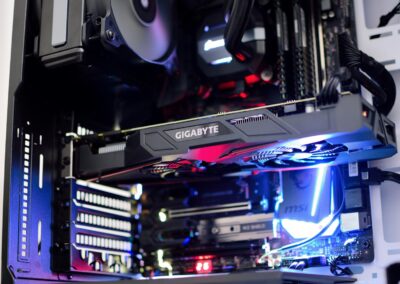Ensuring Seamless Compatibility Across Diverse Digital Platforms
The Importance of Device Compatibility in Today’s Digital Landscape
Device compatibility involves ensuring that digital content and services perform optimally across a wide range of devices, including smartphones, tablets, desktops, and wearables. This requires addressing differences in operating systems, screen sizes, hardware capabilities, and network conditions. For business executives, mid-level managers, and entrepreneurs, understanding the intricacies of device compatibility is crucial for maintaining a competitive edge and meeting the expectations of a diverse user base.
In this article, we will explore the challenges and solutions associated with ensuring device compatibility, emphasizing the role of standardized protocols and optimization techniques. We will also discuss the implications of device compatibility for business success, leadership, and management in the context of modern technology and digital innovation.
Challenges in Achieving Device Compatibility
One of the primary challenges in achieving device compatibility is the sheer diversity of devices and platforms available in the market. Each device comes with its own set of specifications, including different screen resolutions, processing power, and software environments. This diversity makes it difficult to create a one-size-fits-all solution that works seamlessly across all devices. For example, a website that performs well on a high-end smartphone may experience performance issues on an older device with limited capabilities.
Another challenge is the rapid pace of technological advancements. New devices and platforms are constantly being introduced, each with unique features and capabilities. Keeping up with these changes requires continuous updates and adaptations to ensure compatibility. This can be resource-intensive and requires a proactive approach to monitoring and integrating new technologies.
Moreover, differences in network conditions can affect the performance of digital content and services. Variations in internet speed, latency, and reliability can impact how users experience digital platforms. Ensuring compatibility across different network conditions necessitates the implementation of optimization techniques that can adapt to varying levels of connectivity.
Standardized Protocols: A Solution to Compatibility Challenges
Standardized protocols play a crucial role in addressing the challenges of device compatibility. These protocols provide a set of guidelines and standards that developers can follow to ensure that their digital content and services are compatible with a wide range of devices and platforms. By adhering to standardized protocols, businesses can create more consistent and reliable user experiences.
One of the most widely adopted standardized protocols is HTML5, which provides a comprehensive framework for developing web applications that work seamlessly across different devices and browsers. HTML5 includes features such as responsive design, which allows web content to adapt to different screen sizes and orientations. This ensures that users have a consistent experience regardless of the device they are using.
In addition to HTML5, other standardized protocols such as CSS3 and JavaScript frameworks like Angular and React are also essential for achieving device compatibility. These technologies enable developers to create dynamic and interactive web applications that can run smoothly on various devices. For businesses in Saudi Arabia and the UAE, leveraging standardized protocols is key to staying competitive in the digital marketplace.
Optimization Techniques for Enhanced Performance
In addition to standardized protocols, optimization techniques are essential for ensuring that digital content and services perform optimally across different devices and network conditions. Optimization involves fine-tuning various aspects of digital platforms to enhance their performance and responsiveness.
One effective optimization technique is the use of content delivery networks (CDNs). CDNs distribute digital content across multiple servers located in different geographical regions, reducing the distance between users and the content they are accessing. This can significantly improve load times and reduce latency, especially for users in regions with slower internet connections.
Another optimization technique is image and video compression. High-resolution images and videos can consume significant bandwidth and slow down the performance of digital platforms. By compressing these files without compromising quality, businesses can improve load times and enhance the overall user experience. This is particularly important for mobile users who may have limited data plans and slower internet speeds.
Additionally, implementing lazy loading is an effective way to optimize performance. Lazy loading delays the loading of non-essential content until it is needed, reducing the initial load time of a webpage. This technique is especially useful for websites with extensive multimedia content, ensuring that users can access critical information quickly while additional content loads in the background.
Implications of Device Compatibility for Business Success
Enhancing User Experience and Engagement
Ensuring device compatibility is crucial for enhancing user experience and engagement. Users expect digital content and services to work seamlessly across their devices, providing a consistent and enjoyable experience. When businesses meet these expectations, they can improve user satisfaction, increase engagement, and foster loyalty.
In the context of executive coaching services and training programs, device compatibility is essential for delivering effective learning experiences. Participants need to access training materials, videos, and interactive content on various devices, including smartphones, tablets, and laptops. Ensuring compatibility across these devices enables participants to engage with the content anytime, anywhere, enhancing the effectiveness of the training programs.
For businesses in Riyadh, Dubai, and other regions, investing in device compatibility can lead to higher conversion rates and improved customer retention. A seamless and responsive user experience can differentiate a business from its competitors, attracting and retaining customers in a competitive market.
Driving Innovation and Technological Advancement
Device compatibility also drives innovation and technological advancement. By addressing the challenges of compatibility, businesses can develop new solutions and technologies that enhance the performance and functionality of digital platforms. This can lead to the creation of innovative products and services that meet the evolving needs of users.
For example, advancements in AI and Generative AI can be leveraged to create adaptive learning platforms that provide personalized content based on the device being used. AI algorithms can analyze user behavior and preferences, delivering content that is optimized for different devices and screen sizes. This can enhance the learning experience and improve outcomes for participants in training programs and educational initiatives.
Moreover, blockchain technology can be used to create decentralized platforms that ensure data integrity and security across different devices. By leveraging blockchain, businesses can develop solutions that provide secure and transparent interactions, fostering trust and confidence among users.
Leadership and Management in the Digital Age
Effective leadership and management are essential for navigating the complexities of device compatibility and digital transformation. Leaders need to understand the importance of device compatibility and invest in the necessary technologies and strategies to achieve it. This includes fostering a culture of innovation, encouraging continuous learning, and staying updated with the latest advancements in technology.
Executive coaching services can play a vital role in developing leaders who are equipped to handle the challenges of device compatibility. By providing guidance and support, executive coaches can help leaders develop the skills and knowledge needed to drive digital transformation and achieve business success. This is particularly important for businesses in Saudi Arabia and the UAE, where leadership plays a critical role in shaping the future of the digital economy.
Conclusion: Embracing Device Compatibility for a Competitive Edge
Device compatibility is a critical factor in the success of digital platforms and services. By addressing the challenges of compatibility through standardized protocols and optimization techniques, businesses can enhance user experience, drive innovation, and achieve business success. For regions like Saudi Arabia, UAE, Riyadh, and Dubai, investing in device compatibility is essential for staying competitive in the rapidly evolving digital landscape.
By embracing the principles of device compatibility, businesses can create seamless and responsive digital experiences that meet the diverse needs of users. This not only improves customer satisfaction and engagement but also positions businesses for long-term success in the digital age. As technology continues to advance, the importance of device compatibility will only grow, making it a key consideration for businesses and leaders alike.
—
#DeviceCompatibility #DigitalPlatforms #StandardizedProtocols #OptimizationTechniques #Blockchain #Metaverse #AI #GenerativeAI #LeadershipSkills #ProjectManagement #BusinessSuccess #SaudiArabia #UAE #Riyadh #Dubai























